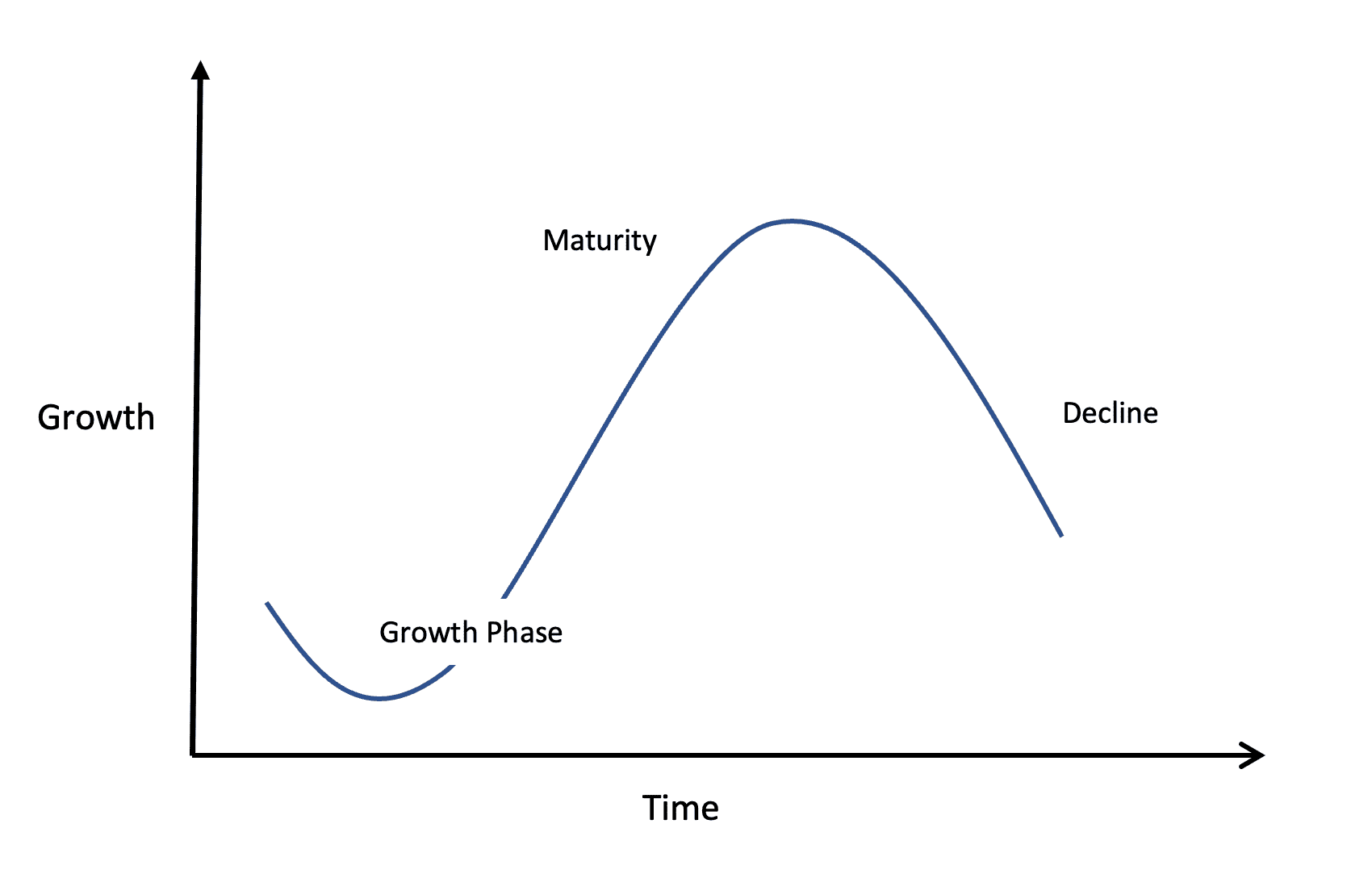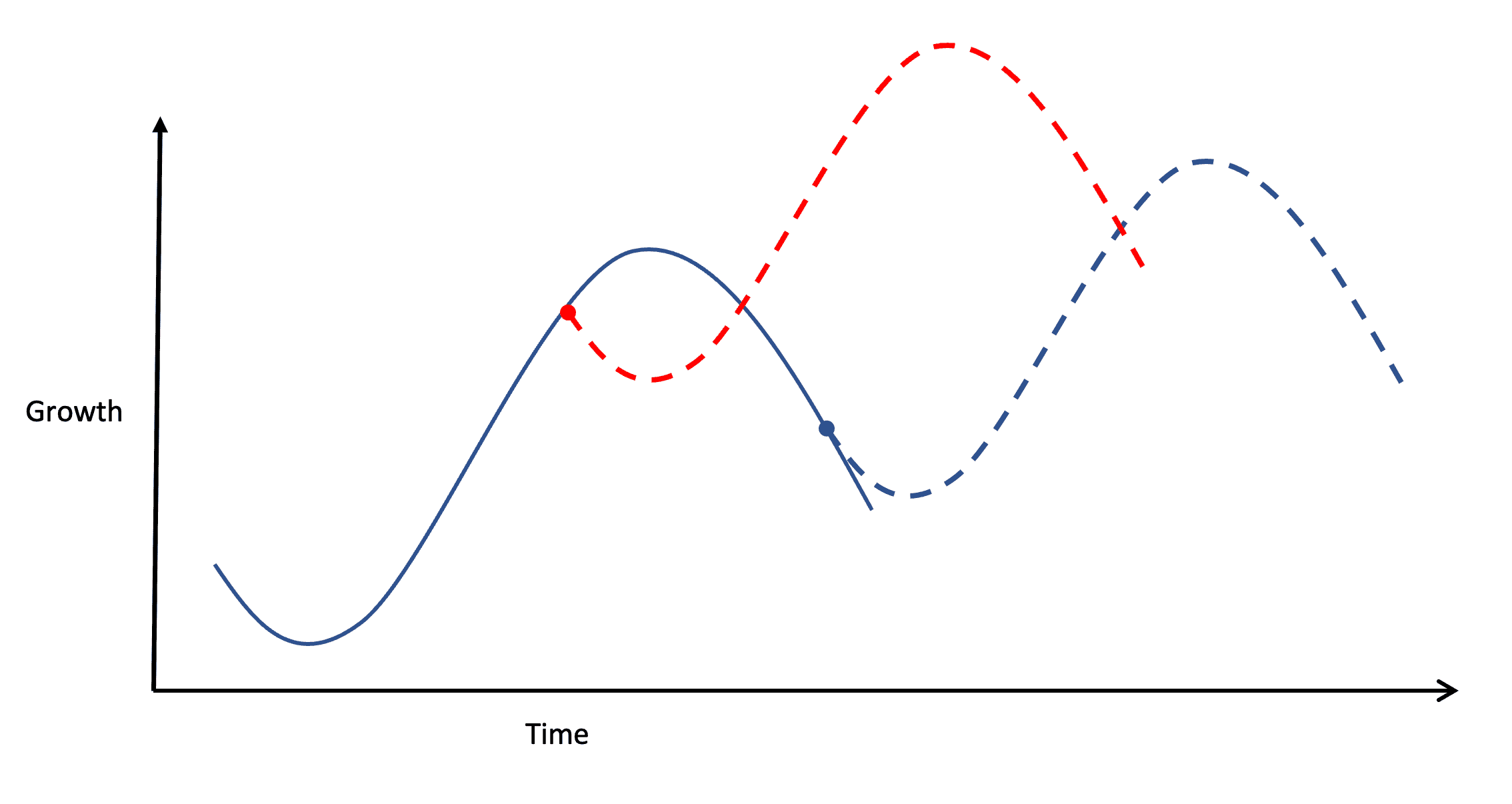The Sigmoid Curve and the Imperative for Nonprofits to Embrace Digital Technologies
Posted: January 24, 2025
Charles Handy, the renowned management philosopher and well-known for the ‘Sigmoid Curve’ principle, once said,
“The key to future success is to have the foresight and discipline to see the opportunities in what you are doing in the present cycle and then to make your moves while things are going well.
If you act too late, you may be in the downward curve and not able to turn things around.” (Handy, 1994)
The sigmoid curve:
Also known as the S-curve, this is a mathematical concept that models the natural growth and decline of various phenomena, including industries, businesses, and technologies.
This curve is characterized by its distinctive ‘S’ shape, which represents three distinct phases: the initial growth phase, the maturity phase, and the decline phase.

In the initial growth phase, often taking years on the timeframe, an organization or technology experiences rapid growth, with innovation and adaptation being the key drivers.
As the curve progresses into the maturity phase, the rate of growth slows down, and the organization or technology becomes more stable and established. However, without proactive measures to sustain growth and innovation, the curve eventually enters the decline phase.
In this stage, the organization or technology faces stagnation or obsolescence, ultimately leading to a loss of relevance and diminishing returns.
Making organizational changes:
Understanding the sigmoid curve principle is crucial for organizations, including charities and non-profits, as it highlights the importance of anticipating and adapting to change. By recognizing their position on the curve and proactively investing in new technologies or strategies, organizations can maintain their relevance and ensure long-term sustainability.
For us, the sigmoid curve principle serves as a reminder for charities and nonprofits to think about newer technologies and methods of donating while they are still in the growth or maturity phases, thereby securing their future success.
Making change during the maturity phase (the red dotted line on the diagram below) is of paramount importance because it provides organizations with the necessary resources, stability, and momentum to adapt and innovate effectively and enables them to achieve greater success sooner and with more impact.
In this phase, organizations have already established their presence and developed a solid foundation, which allows them to focus on improvements and explore new opportunities without the risk of jeopardizing their core operations.
Note that in the sigmoid curve theory, there is usually a period of potential conflict and confusion after the change. It is where the errors get sorted out, new patterns of working are sorted out, and new learning takes place. But it is overcome. You can see the organization moves to a new, higher sigmoid curve pattern.
More growth, more success.

Conversely, attempting to make significant changes during the decline phase (the blue dotted line), can be considerably more challenging and less effective. It’s not impossible of course, but at this stage, organizations are already grappling with diminishing returns, waning relevance, and potential obsolescence, which can hinder their ability to invest in new technologies or strategies.
Additionally, the decline phase often sees a decrease in morale, making it harder to rally the support needed to embrace and implement change. The phase where worry and uncertainty happens, is that much harder to overcome. Again, it isn’t impossible to change at this point. Just harder.
By taking proactive measures during the maturity phase, organizations can avoid the pitfalls of the decline phase and ensure a smoother transition to the next phase of growth, thereby maintaining their long-term viability.
Waiting too long could result in organizations falling behind the curve and losing the ability to adapt and grow. Digital technology and digital giving of all forms have already demonstrated immense potential in transforming various industries, and the philanthropic sector must recognize the importance of integrating it sooner rather than later.
The days of just accepting checks or cash in buckets are increasingly over. Just accepting a card payment expensive.
Applying the Sigmoid Curve theory to nonprofits and digital technologies :
The question, then, is not whether nonprofits SHOULD embrace newer digital technology but WHEN to make the leap.
Here at Better Giving, we facilitate direct donations from donors to beneficiaries.
These use a variety of digital routes, that as we look at nonprofit webstes, we see a worrying number NOT taking advantage of.
1) Card payments – the first step. But nonprofits often have these as part of a long and convoluted form, that puts people off completing the process. They can also be expensive, especially for larger donations and when using intermediaries that take large fees.
2) Digital wallets: So few have this enabled, yet increasing numbers of people use mobile technology to access websites. Phines and tablets. If you do not have such as apple or google pay enabled, they the donor has to go through the convoluted card process again, whereas they could have donated literally at the click of a button!
3) DAFs: about $38 BILLION is estimated to be locked up in Donor Advised Funds, ready to be donated to a nonprofit. Making it easy for donors to donate using their DAF means you have access to these often High Net Wirth individuals and their funds. Even fewer have this on their donation forms.
4) Cryptocurrencies: Donation forms that accept Crypto donations are seen even less, even though it is a growing route for people to use. Often tax efficient for the donor, crypto and ‘blockchain’ technologies are supposed to reduce costs. yet unbelievably, many nonprofits that DO accept crypto pay more for the service, even before they have accepted a single cents-worth of crypto! Great to start that crypto donation process – make sure you do not get overcharged!
The sigmoid curve principle serves as a timely reminder for charities and non-profits to recognize and capitalize on the opportunities presented by digital technology. Do it now. Not when it’s too late
And by doing so, they can ensure long-term sustainability, improve transparency, reduce costs, and foster trust among donors, ultimately enhancing their ability to make a meaningful impact in the world.
Better.Giving – It’s never too soon to start
References:
Handy, C. (1994). The Empty Raincoat: Making Sense of the Future. Hutchinson.
